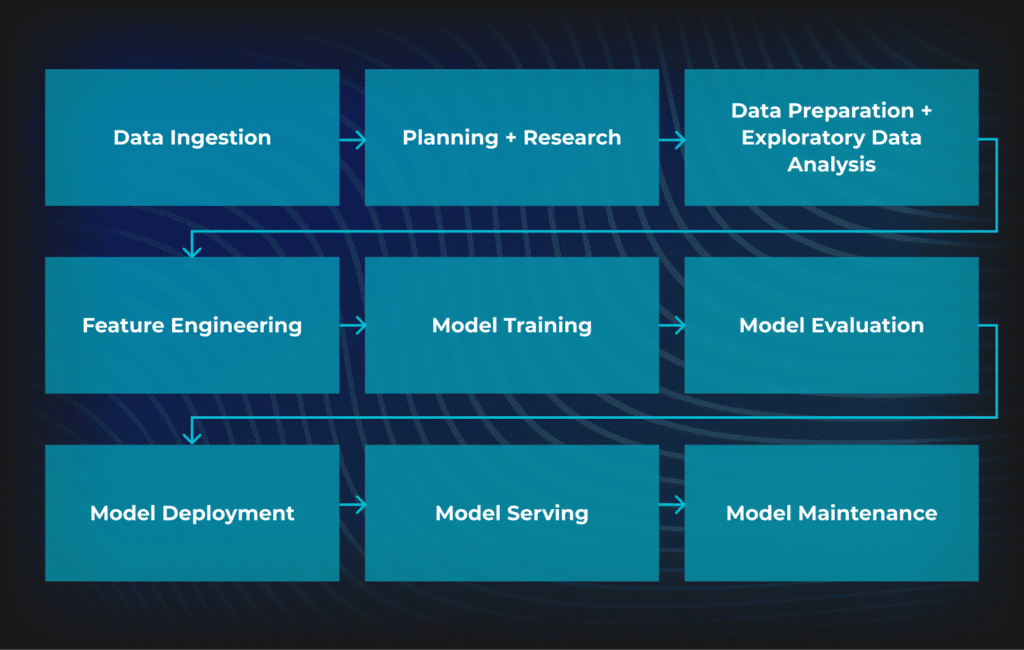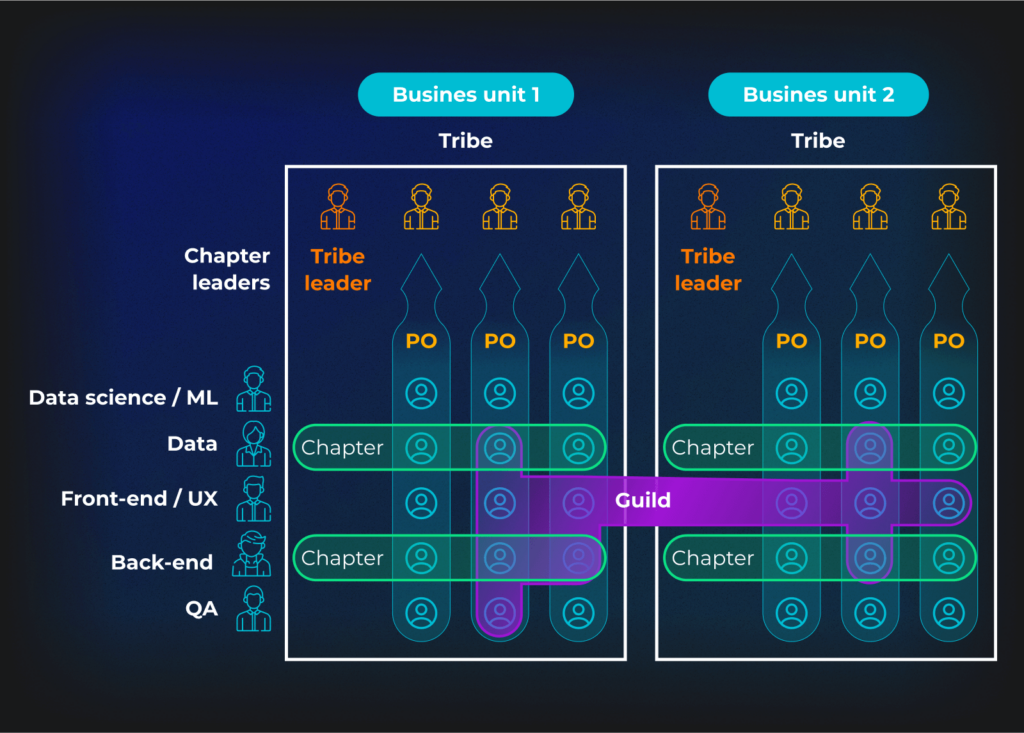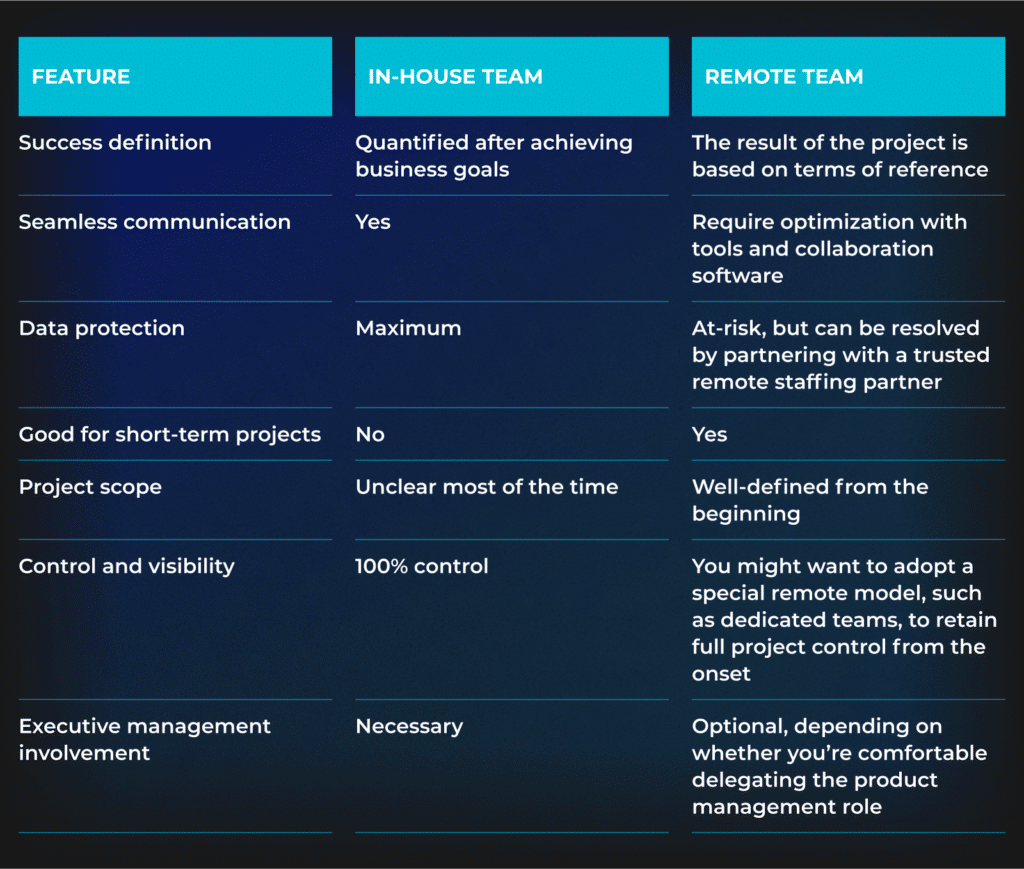Building a Successful Machine Learning Team for Your Business
Machine learning (ML) adoption is no longer an experiment but an essential component of business practices and planning. Today, machine learning is a part of every industry you could imagine, whether healthcare, retail, eCommerce, manufacturing, entertainment, or finance. Moreover, the global machine learning market is poised to expand at a compound annual growth rate of 38.8% and reach $209.91 billion by 2029, thanks to the technology’s endless use cases and opportunities.

One way of tapping into the tremendous potential of ML is by building a machine learning team to execute your strategies, ideas, and plans. A highly-qualified professional team brings in the required skill sets and expertise to research, design, train, and implement advanced ML models in your special use case.
Our experts have built top-performing machine learning teams for businesses across diverse industries for years. In this article, we share valuable insights into how to build a machine learning team from scratch, including steps and challenges to expect. Keep reading to also learn about the main roles and typical structure of a machine learning development team.
Reasons for Creating a Machine Learning Team
In this new age of digital acceleration, machine learning is a frontrunner in the category of technologies that help organizations save costs and drive efficiency. As a key component of Artificial Intelligence (AI), ML augments the capacity of your organization to automate and improve data with a reduced scope of human intervention. For starters, you would want to hire a machine learning engineering team for the following reasons:
Natural Language Processing (NLP)
Machine learning engineers can help you implement various Natural Language Processing (NLP), such as Gensim &NLTK, allowing your business to scale language-related tasks. With NLP, your software systems can read text, hear speech, and interpret it for in-depth analysis. This approach can be helpful in analyzing customer sentiments across unstructured documents, like emails, to identify areas of optimization.
Machine Learning Operations (MLOps)
Setting up a team of remote machine learning developers can help companies stay on top of emerging ML trends, such as Machine Learning Operations (MLOps). MLOps include a set of practices that enable your development team to simplify work routines by automating deep learning and ML deployments. The concept is handy when there is a need for greater efficiency and reliability to deploy a machine-learning model for large-scale production.
Data Modeling and Evaluation
ML developers have in-depth experience in an array of data modeling and evaluation techniques, including Classification Accuracy, F1 Score, and Logarithmic Loss. With these concepts, your organization can analyze vast data sets to understand their quality, structure, and characteristics to enhance the performance and accuracy of ML models. The concepts can also be replicated to draw meaningful insights from raw data.
Audio and Visual Processing
An AI ML development team can help you build an audio and vision-based digital product for automating the process of extracting, analyzing, and classifying data from videos, images, and audio. By tapping into audio and visual processing technologies, you can ensure that your marketing campaigns target a wider audience, including people living with disabilities. ML experts can leverage a range of concepts and technologies to implement this, including TensorFlow, Fourier transforms, and music theory.
Advanced Signal Processing
Another reason to hire ML developers is to integrate advanced signal processing into your business systems. This can help your organization benefit immensely from digital signal processing (DSP), which extends to relaying critical business information with minimized distortion, noise, or interference. In addition, unlike analog circuits, DSP is easier to design, relatively affordable, and offers greater flexibility.
What Challenges Do You Face in the Process of Making a Machine Learning Development Team?
Like any other technology, machine learning has its share of hurdles that stall many companies from adopting it at a full scale. For example, you’ll likely encounter several challenges when assembling a machine learning product team for the first time, including:
Talent Shortage
The talent shortage is still a big problem in the IT recruitment industry, and it’s estimated to cost companies up to $8.5 trillion in revenue losses globally. For this reason, 35% of employers want to hire over 50 developers within a year to fill vacant positions quickly and get ahead of the curve to compete favorably. For organizations looking to build a machine learning team, this means stiff hiring competition, not to mention the challenge of finding value-matched candidates with unique skill sets.
Solution
To mitigate this bottleneck, it’s important to invest in a robust hiring strategy that gives you access to global talent pools for full-time or freelance roles. If you want to build an in-house team, you can partner with academic institutions to offer internship and mentorship programs to identify potential employees and start engaging them as early as possible. Alternatively, you can turn to data science outsourcing and alike strategies to combat talent shortage.
Understanding the Business Problem
This is a challenge that many companies overlook, as there is an inherent bias on the role of developers or ML engineers in a project. For many, these professionals are simply problem-solvers and should be evaluated based on individual hands-on keyboard time. But in reality, tech talents should participate more in business meetings, review user feedback, and issue recommendations to find holistic solutions to your exact business problems. This means ensuring that they properly understand the project’s requirements.
Solution
The first step to ensuring that your ML team understands underlying business requirements is to communicate your expectations beforehand. During onboarding, talk to the team and share a detailed guideline with the team, highlighting:
- The scope of the machine learning tasks
- Type of data needed to train the ML models
- Performance metrics for the machine learning model evaluation
By reading and internalizing this guideline, your team will be in a position to define business requirements and implement them in the project. Moreover, you’ll have a mutually agreed-upon assessment rubric to evaluate whether the team meets your expectations.
Team Collaboration and Communication
Another big challenge in assembling and managing machine learning teams is collaboration. ML projects require interdisciplinary communication and in-depth collaboration among data scientists, software developers, and business leadership for successful outcomes. While implementing this, you might find it difficult to bridge the gap between the technical and non-technical people on the team.
Solution
Inculcate a culture of collaboration among team members. For instance, you can create a routine for regular meetings, cross-functional idea exchange platforms, or simple brainstorming sessions to foster a cohesive working environment. On top of that, hire candidates with a strong background in soft skills to build a team whose members can co-exist peacefully and resolve issues amicably. This means they should also be ready and willing to learn new management practices.
Data Availability and Quality
Data is a critical component of a typical machine learning development lifecycle. However, it is increasingly getting difficult to access high-quality and relevant data that can be used to train ML models. This means your team will find it challenging to train a model that specifically addresses the unique needs of your organization or spend productive time retrieving information from scattered, messy, or not readily available sources. Besides contributing to project failure, poor data quality also leads to poor employee experience and performance.
Solution
You can solve this problem by establishing a robust data management practice and infrastructure to supply reliable and consistent business information to the development team. Most importantly, find an experienced person, such as a data engineer, to handle big data development. The expert will clean, normalize, and handle missing data, ensuring that the team has access to the highest quality information for training ML models.
Limited Resources for ML Projects
Another challenge that can limit the success of your machine learning team right from the onset is limited development resources. The OpenAI frenzy has encouraged many businesses to capitalize on the artificial intelligence boom, causing a spike in demand for components used to build specialized AI software, such as server chips.
According to the latest industry news, there is a rampant shortage of server ships globally, a situation that has forced giant cloud service providers, such as Google, AWS, Oracle, and AWS, to limit hardware availability for customers. In fact, J.P. Morgan & Co. predicts the chip shortage to remain throughout the year and run into 2024. This can mean up to a months-long wait time before you can rent advanced hardware to implement your ML or AI project. As to your team, members may start leaving if the wait is too long.
Solution
While you might not be able to control the macro-factors causing shortages in the supply of AI/ML hardware components, you can still plan adequately to increase the chances of your project’s success. This includes setting up enough budget to match higher rates that service providers will likely charge as a result of heightened demand. The faster your team settles and gets access to all the needed resources, the higher the job satisfaction and retention rates.
What are the Main Roles of in ML Engineering Team?
A typical machine learning project requires multiple roles, each assigned to various components of the development lifecycle.

Here is a profile of the different types of roles that you’ll need to hire for an end-to-end ML development lifecycle and the things to consider:
Product Manager
The product manager is a key member of an ML development team and ensures the expectations of the stakeholders and customers are met in the end product. It’s also the responsibility of the product manager to conduct consumer surveys and collect feedback for improving UX, as well as create a product roadmap and metrics for measuring business impact.
Skills and tech stack
Excel and SQL proficiency
Product design, marketing, and management
Data analytics
Ability to use productivity software
Data Engineer
A data engineer is a handy colleague in an ML development team and is responsible for building and maintaining data pipelines. The engineer is also responsible for setting up internal tools to gather, clean, and process vast data sets for use in defined ML use cases. Learn how to hire a big data developer in easy steps.
Skills and tech stack
Data manipulation and preprocessing
Programming languages: Java, Python, C++
Framework: Apache Hadoop
Databases: MongoDB, Hive, Cassandra, Postgres
Data Scientist
Adding a data scientist to your project is highly recommended, as the expert will help identify and validate viable business use cases that can be addressed with self-learning programs. Developers with data science skills can also build custom tools and libraries to automate the data modeling workflow process.
Skills and tech stack
Programming languages: Python, Java, R
Deep learning: PyTorch, TensorFlow, JAX
ML: Fast.ai, AllenNLP, Scikit-learn
Cloud: AWS, Azure, Google Cloud, S3
Visualization tools: Matplotlib, Bokeh
ML Engineer
The machine learning engineer is responsible for testing candidate models to optimize their latency and throughput before deployment to production. The engineer also monitors the model on an ongoing basis to optimize, debug, and maintain it as much as needed for optimal performance.
Skills and tech stack
Programming languages: Python, C++, Scala, Bash
Operating system: Linux
ML: Fast.ai, AllenNLP, Scikit-learn, OpenCV
Serving: TorchServe, TensorFlow Serving, TensorRT
Software Engineer
A software engineer is critical to your project as they will build the tools, frameworks, and infrastructure needed to support an end-to-end machine learning process. Moreover, a developer with software engineering skills will integrate the ML project with existing applications to ensure seamless compatibility between the ML model and the organization’s broader tech ecosystem.
Skills and tech stack
Programming languages: JavaScript, Python, Java, C++, and Ruby
Database management: MySQL, MongoDB, PostgreSQL
Testing and debugging
Analytical thinking
Research Scientist
Given the dynamic nature of the tech landscape, it’s imperative to include a research scientist to evangelize disruptive concepts, ideas, and use cases. By staying on top of emerging ML trends, the research scientist will design initial ML prototypes and perform systematic experiments to help the team adopt the best-in-class ML approaches.
Skills and tech stack
Deep learning: PyTorch and TensorFlow
ML: Fast.ai, AllenNLP, Scikit-learn
Hands-on experience with Jupiter notebooks
Strong oral and written communication
An Efficient Structure of a Machine Learning Team
Effective team structures used to manage machine learning team depend on several factors, including an organization’s development needs and goals. For instance, a company that wants to implement machine learning applications gradually might want a team connected to its business intelligence department or set up in a global R&D center. Some businesses might also deem it feet to build a fully-fledged AI/ML department and hire talent to work as full-time employees.
The possibilities of effective team structures are endless and can all be implemented to serve diverse business goals. However, to get the most out of your team structure, you can adopt Spotify’s “squad framework.” In this structure, people include professionals from diverse verticals, making a cross-functional team for training and implementing machine learning models.
Other notable characteristics of this team structure include:
- The working environment is headed by the engineering department lead
- The product manager communicates stakeholder requirements to align team members’ priorities
- The machine learning team structure can be scaled seamlessly by adopting the concept of tribes

Steps of Building Productive Machine Learning Teams
Assembling a team of experts for machine learning implementation can be a turning point for unprecedented business success and customer satisfaction. Netflix is a good example to demonstrate this. According to statistics captured in a recent Harvard paper, Netflix became the world’s leading streaming platform after implementing machine learning algorithmic recommendations, where 80% of watched content emanates from. Consequently, the company saves as much as $1 billion annually thanks to declining churn rates.
You can also develop a machine learning team from scratch and turn it into a highly productive business extension for positive prospects like Netflix. Here are the steps to follow:
Define Project Goals and Scope
The first step involves assessing the actual business problems that can be solved by machine learning integration. Conducting this evaluation will help you clearly define the goals, scope, and expectations of the ML project at hand.
List Down the Required Skills
After that, list down the skills and level of expertise required to successfully complete the project. This will help you determine the tech roles to hire, as well as the domain knowledge to prioritize, whether data science, software engineering, or machine learning.
Find and Hire Value-matched Candidates
The next step is to create a detailed job description and share it online to find and interview potential candidates for the positions. While you can attract competent candidates on social media or other online developer forums, it would be better to work with a full-service partner to relieve you of the hiring bottlenecks. An experienced partner like Newxel will take a custom approach to interview and hire value-matched candidates who understand your exact business requirements, saving you time and peace of mind to focus on core business functions.
Provide Training, Resources, and Tools
After hiring the candidates, take them through a small induction period after onboarding. During this time, provide all the necessary training, resources, and tools to equip the team for the task ahead and prepare it for success.
Define Workflows and Processes
For quality consistency and streamlined development, it will help if you clearly define workflows and processes. Describe the best development practices to adopt, document coding standards, and implement robust version control policies to ensure everyone is always on the same page.
Measure Performance and Recognize Achievements
The next step is to measure the performance of the team members to determine progress and whether their input will drive desired results in the long haul. To foster excellence and a culture of motivation, recognize achievements with awards, and provide constructive feedback whenever needed.
Build an Internal Machine Learning Team or Hire a Remote Team: Compare the Features of Both to Make the Right Decision
A typical ml/AI team structure can include team members working remotely or as full-time employees reporting to the organization’s premises. Here is a comparison of features between the two models to help you make the right decision:

How Much Does It Cost to Build an ML Team?
The cost of hiring an in-house team
Retaining a qualified machine learning engineer on a full-time basis will cost you an average of $155,758 per year, depending on tech skills and seniority. However, it will help if you also understand other costs associated with retaining an in-house team, including overhead expenses, such as office rent and insurance. You might also need to pay government-sanctioned employee benefits, such as retirement contributions, social security, and 401(k) plans.
The cost of building a remote team
Hiring remote machine learning engineers in Eastern Europe countries like Ukraine costs an average of $4,000 per month, depending on skills and tech stack. On top of that, you might also make an additional payment of up to $1,500 per month to cater to the team’s commissions, tips, or cash bonuses.
How Newxel Can Help with Building an AI/ML Development Team
Newxel is a full-service company with robust experience in hiring tech talents for business across all industries. With our global recruitment capacity, we can help you assemble a business-ready machine learning team in 3 to 5 weeks, allowing your organization to implement ML trends as soon as possible and leapfrog the competition. We have robust and developer-friendly work policies that allow us to make a machine learning team more productive and interested in long-term engagement. Contact us today to build a team with a super-high retention rate of up to 94%!
Conclusion
In a business world that flourishes in disruptive technologies, machine learning is worth your company’s time and investment, especially if you’re going to retain customers, lower operating costs, and scale with minimum effort. Leverage this guide to build a machine learning team from scratch and deploy ML models that give you a competitive edge in your respective domain.






